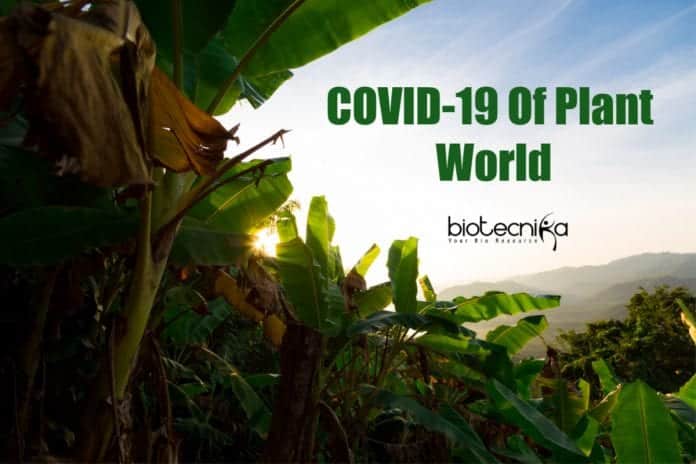‘Banana Covid’ Hits Plantations – COVID-19 of the Plant World
Described as the equivalent of Covid-19 in bananas by scientists, a novel fungus strain that has devastated plantations across the globe this year, “fusarium wilt TR4”, is threatening output in India, the world’s largest producer of bananas, as it is setting up new hotspots around the world.
The Tropical Race 4 (TR4) strain has reached as far as Latin America as it jumped from Asia to the Middle East and Africa after it was first identified in Taiwan. First, it attacks the leaves making it turn yellow from their trailing edges before wilting away and it cripples plantations this way. There is no effective remedy so far.
The National Research Centre for Bananas (NRCB) Director, Trichy, S. Uma said, “It can be said as the Covid-19 of the plant world, in India, hotspots have been found in Uttar Pradesh and in Bihar.”
TR4 is one of the “the most destructive of all plant diseases”, according to the Food and Agriculture Organization of the United Nations. There is no treatment yet just as with Covid-19. Hence, to slow its spread, scientists recommend biosecurity measures including plant quarantine. The $26 billion global
banana trade has been jeopardized by the spreading disease.The disease breaching borders through imports is a reason to worry. According to the FAO, banana, a healthy snack, is the world’s most globally exported fruit.
India grows about 100 named cultivars (varieties) and produces 27 million tonnes of bananas annually. A curvy yellow fruit, Grand Nain (Musa acuminata), the most commonly sold variety has been infected by TR4.
The banana prices are pushed up with the inability to contain TR4. According to the Hyderabad-based National Institute of Nutrition, one medium banana (126 gms) provides about 15 grams sugar (naturally occurring), 28 grams carbohydrate, 1 gram protein, 0 gram fat, 110 calories, trace quantities of vitamin C and B6, and 3 grams fiber and 450 mg potassium.
Scientists have not been able to ascertain how TR4 entered India, and currently, the epicenter is the largest exporter, Ecuador.
Fusarium wilt has occurred in the past. In the 1950s, the dominant export variety of bananas, Gros Michel was entirely wiped out. A new resistant variety, Grand Nain, came up in response to this, which has fallen to TR4 now. Developing or identifying new resistant varieties is the challenge. Just as the world is struggling to find a Covid-19 vaccine, until an effective agent is found, that is the only way to manage it according to Uma.
The president of the Indian Academy of Horticulture Sciences, KL Chaddha, known as the Father of Indian Horticulture said, “Maybe around eight-nine months ago, this strain entered India.”
Uma said, “In our country, Grain Nain accounts for 62% of commerce, including exports, and 55% of the country’s banana area.”
According to the NRCB, the hotspots in India are Maharajganj in Uttar Pradesh and Katihar and Purnea in Bihar. Scientists have set up an experimental farm in the hotspot Katihar. Several cultivars are grown in this and 32 have shown potential resistance to TR4. The trials have begun.
“Biopriming”, a set of measures, has been recommended by the Indian Council of Agricultural Research. They have asked farmers to abandon the plantations that have been affected. Before returning to grow banana, they must grow rice for a year or two, A scientist with the NRCB, R Selvarajan said, “The chain will be broken this way.”
The FAO states in a briefing document, “To prevent the spread of the disease, it is evident that a concerted effort is needed from the government, international organizations, research institutions, and industry.”
Source
Banana Covid Hits Plantations































Very informative
I am B. Tech and biotechnology students